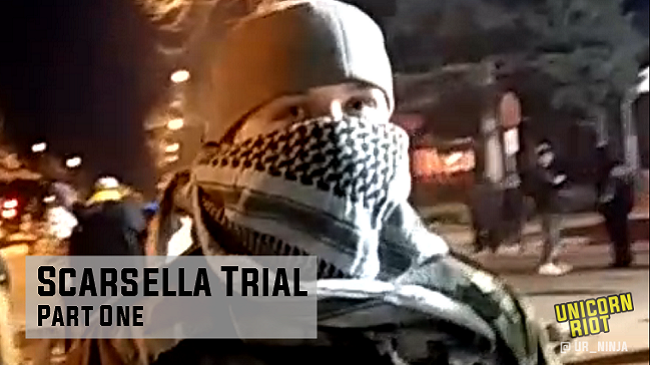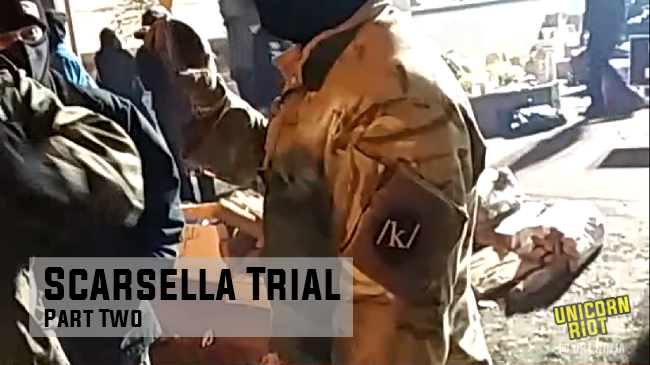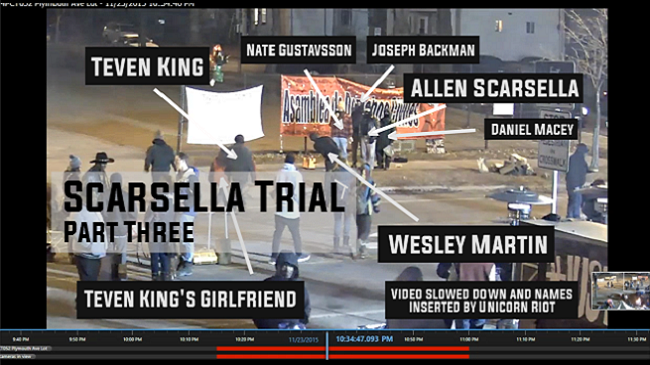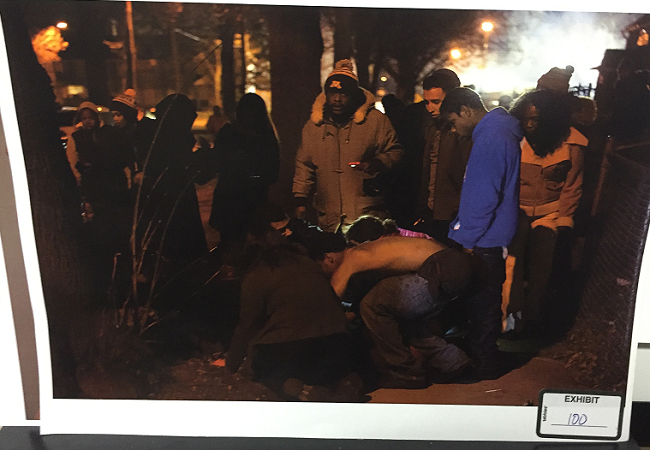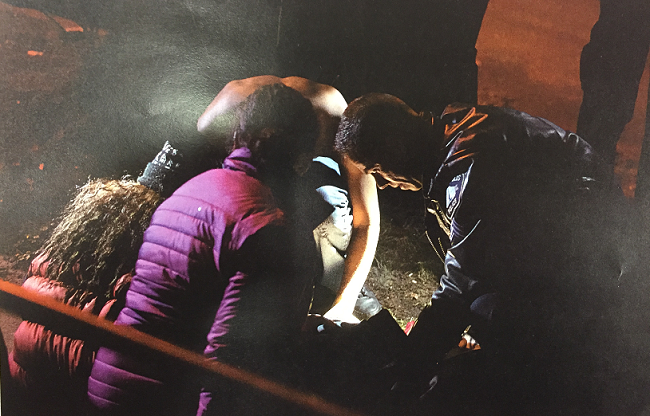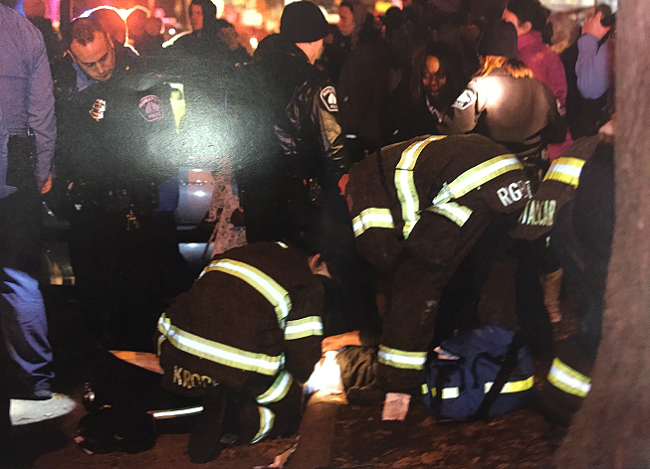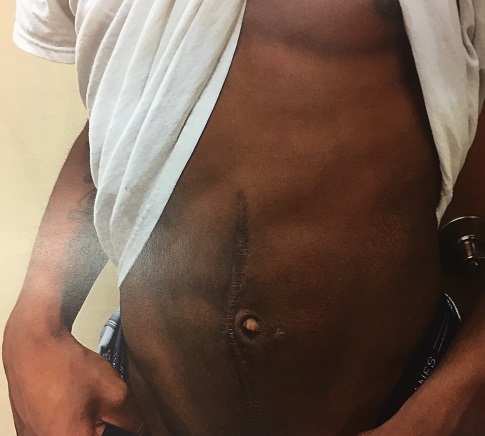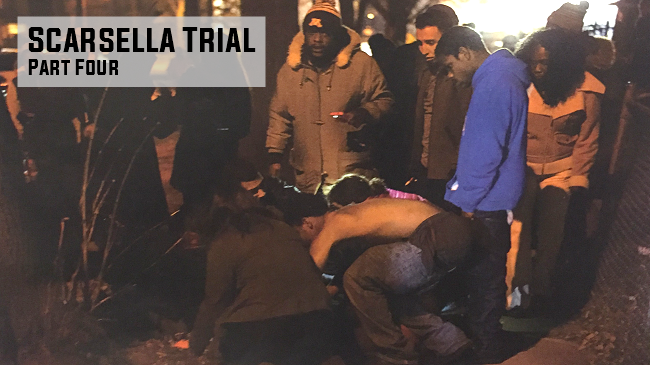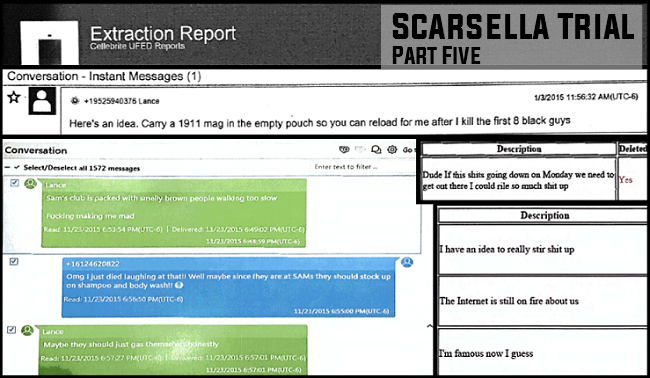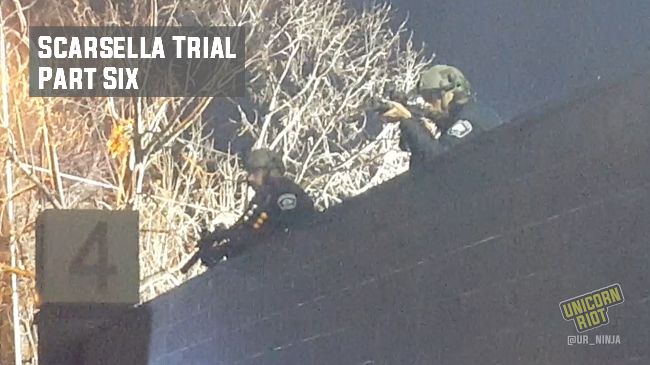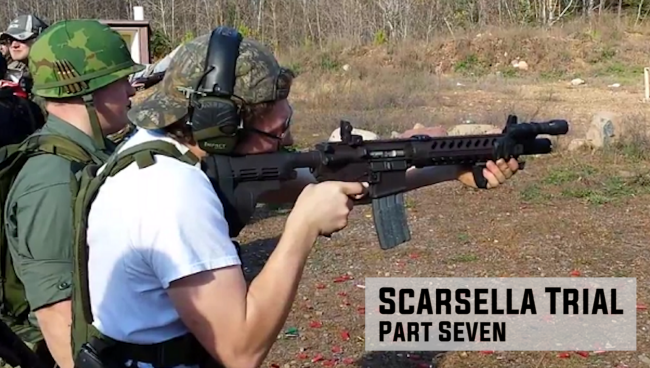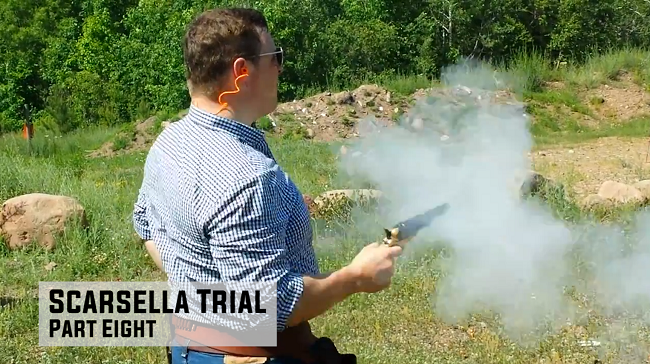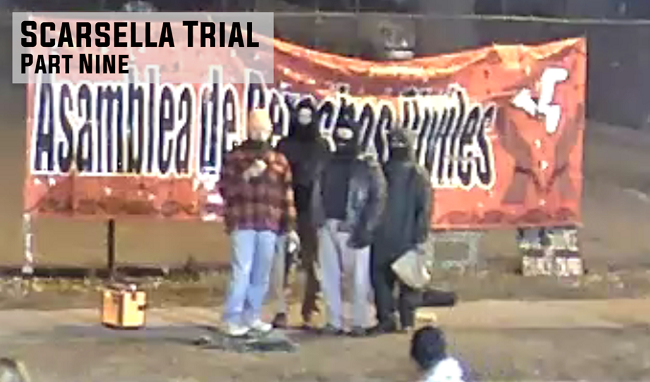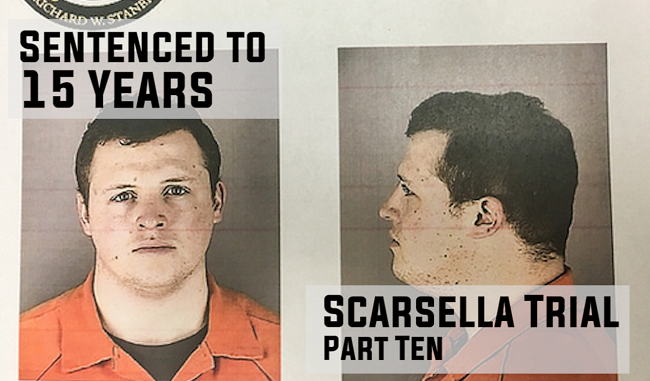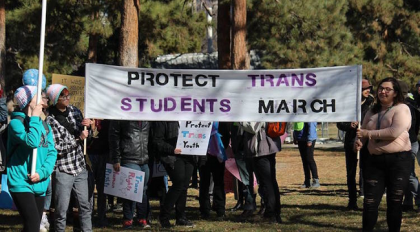Scarsella Trial – Part Four: Shooting Victims Testify
Minneapolis, MN – White supremacist Allen ‘Lance’ Scarsella shot five unarmed Black protesters in North Minneapolis on November 23, 2015. Protests for Jamar Clark, who was executed by the Minneapolis Police on November 15, led to an outdoor occupation of the 4th Precinct police station, blocks away from Jamar’s death, and a block away from where Scarsella emptied a magazine on a group of protesters who had followed him after asking him to remove his mask.
Allen Scarsella, who turned 25 years old on February 25, had claimed self-defense but on February 1 was found guilty on all twelve felonies levied against him. Scarsella’s sentencing date has recently been rescheduled from March 10th to April 26th, 2017. This is the fourth part of Unicorn Riot’s comprehensive report-backs from the Scarsella Trial, covering testimony and exhibits from January 20, 23, and 24, 2017.
Read Scarsella Trial – Part One: Jury Selection, Unicorn Riot Subpoenaed, Opening Statements, Scarsella Trial – Part Two: “In hindsight it was very stupid”, and Scarsella Trial – Part Three: Jury Sees Videos Around Mass Shooting by clicking on the images below:
Testimony was given by all five victims of this act of domestic terrorism: Cameron Clark, Walter Hoskins, Teven King, Draper Larkins, and Wesley Martin, all unarmed Black males who were present at the protests for Jamar Clark. Documentation of this testimony is below.
[Content Advisory: some of the language seen in this article may be disturbing and offensive]
Watch the video below for a timeline of events that led to the shooting:
WITNESS TESTIMONY – DAY FOUR (JANUARY 20)
(Names of people on the stand testifying are signified by italics)
Testimony in the State of MN V. Scarsella trial continued on Friday, January 20 in Judge Hilary Lindell Caligiuri‘s courtroom on the sixteenth floor of the Hennepin County Government Center. A doctor led off the day’s list of witnesses and a freelance photo-journalist named Chris Juhn was next. Juhn attended the protests at the 4th Precinct for at least “twelve days” of the eighteen days, at times as long as “eight a.m. to two a.m.” Juhn was present at the protest on November 23, 2015, the night of the shooting.
Juhn was brought forth as a witness to provide evidentiary photographs for the prosecution. The State of Minnesota permitted fifteen of his photos to be shown to the jury. When the photos were being shown, he explained that the metadata on the photographs was off by one hour because of daylight savings time.
Among the dozen plus pictures shown to the court were images of groups of people having discussions and hanging out at fire pits that were in the street on Plymouth Avenue. The photographs include multiple pictures of families, women and children, and even pictures of victims before and after the shooting.
Juhn’s pictures give a snapshot of the night as the first exhibit, Exhibit 90 was time stamped at 6:45 p.m. and the last exhibit, 103, was minutes after the shooting, around 10:45 p.m. Juhn captured the moments directly after the shooting; pictures show many of the community members present at the protests springing into action and helping the victims of the shooting.
In the pictures, two of the victims, Teven and Wes, can be seen getting tended to by community members along with paramedics and firefighters as onlookers gather in disbelief.
While answering questions from Assistant Hennepin County Attorney Hawley, Juhn, who appears as a white male, said that he “felt comfy” at the protests and wasn’t picked on or subjected to any prejudice because of his whiteness. He stated that he had worn a mask and “at first it wasn’t a big deal,” but that changed after the first visit by Scarsella (on November 19); he was later told to take his mask off.
He stated that before the shooting on the night of November 23, the community at the 4th Precinct was very calm. After the shooting, Juhn thought that he had captured pictures of the license plate belonging to the shooters. He was taken down to Minneapolis City Hall by the police who then took Juhn’s SD card from his camera, copied it to a computer, and did a brief interview with Juhn about what he witnessed.
Scarsella’s defense attorney Heinrich cross-examined Juhn, focusing mainly on trying to understand how well Juhn knew the victims and labeling him a “normal attendee” at protests. Defense attorney Heinrich brought up how Juhn had mentioned that he heard the words “white supremacist” and “gun” in his interview with lead investigator O’Rourke the night of the shooting, and that now in his testimony to the court he couldn’t recall hearing that. Juhn was then excused from the stand.
After a small break for a juror’s bloody nose, the jury came back in to the courtroom. A juror told the judge that they knew the first witness of the day “in passing”, but when neither side took issue with this information the judge moved the court proceedings along. Scarsella, who in the meantime had been very still and quiet, handed a loose-leaf piece of paper folded in half with words on it to Heinrich.
SHOOTING VICTIM TEVEN KING
[The seriousness of Teven King’s injuries were the reasoning behind the most serious charge levied against Scarsella, 1st degree assault.]
The next witness called by the state was shooting victim Teven King. As Teven entered, Scarsella looked back and watched as Teven walked into the court area and was subsequently sworn-in. King is twenty years old, is five feet and seven inches in height, and weighs one hundred and thirty pounds.
During testimony, King stated that he had heard about Jamar Clark’s murder on the news and that he went to the protests “to stand up for what was right”. He said:
“I felt grief and felt bad for his family and wanted to pay respect to his family.” – Teven King on why he attended protests
Teven told the court he knew two of the other four victims before the shooting, Cameron Clark and Wesley Martin, and on the night of the shooting he said that he was at the 4th Precinct protests on Plymouth Avenue hanging out with his mom, his cousin, his girlfriend, and Wesley. King stated that he had drank some Hennessey and smoked “a little bit of pot” during the night of the shooting.
King said he was “sitting by the fire” when he and Wesley saw Scarsella and his three cohorts enter the protest area. King said “I just seen the mask and that just kind of tripped me out. I don’t like masks, I like to see people’s face.”
“Me, my girlfriend and Wesley went over there,” King continued, described the situation when they went to speak to Scarsella’s group by the fence. King said that “they [Scarsella and cohorts] got defensive” when they were asked to remove their masks. King pointed out that Scarsella and Nate Gustavsson, who was in a orange hat, were the only members of the group of four that were interacting with the protesters, and added that all four of them refused to take off their masks.
Because of the refusal and the negative tone of the interaction with Scarsella, Gustavsson, Backman, and Macey, King said “we were trying to escort them off the premises without anything conflicting. But, things conflicted.” As the small crowd was escorting Scarsella and his cohorts out of the area, walking north on Morgan Avenue, King said that Gustavsson, the “guy in the plaid jacket, got hit” by an “older dude” and that “protesters were pulling him off.”
King said that as he approached the intersection of 14th and Morgan Avenues, Scarsella pulled a gun out.
“I turned around and looked at him and he just shot … I felt the bullet but I didn’t fall right away, I had a chance to actually run.” – Teven King
After being shot in the stomach, King ran almost halfway down the 1300 block of Morgan Avenue until he “lost feeling in [his] legs” and fell down. Protesters rushed to his aid.
“I felt like I was gonna die … my head just felt light … it felt like someone had stuck their hand in my stomach and just turned it, that’s how bad it felt.” – Teven King
Exhibit 110 was then re-shown to the court. The video had been displayed to the court previously on January 19 and was featured in Part Three of our Scarsella Trial report-backs. It shows Scarsella’s group enter and leave the protest area after having discussions with people, the first of which were King, his girlfriend, and Wesley Martin. Watch the video by clicking on the image below.
After being shown a couple minutes of Exhibit 110, jurors took their morning break, and upon return the video resumed playing. The prosecution stopped the video at the 10:38:58 mark, and King stated, “we were just walking up [following Scarsella and Gustavsson] and we made it to the corner [near 1345 Morgan Ave. N.] and they were walking across the street [14th Ave. N.] … we stopped at the corner for a second, then we commenced to walk back to the protest.”
King went on to testify that his girlfriend was in front of him when they started to walk south back to the precinct, and said that when he glanced back at Scarsella for a “quick look at him” he saw Scarsella pull out his gun and fire it.
“I stumbled backwards, fell, flipped back up on my feet and ran.” – Teven King describes his actions after being shot in the stomach
Exhibit 5, a red scarf that Teven wore the night of being shot, was then shown to the court. The scarf was found near where King was shot, at the end of the 1300 block on Morgan Avenue. King said that he got the scarf “from the protest … they had a bin with scarves, gloves, hats, and hand warmers for anybody.”
When King got a chance to look at the scarf while on the stand, he denied that the scarf in evidence was his based on the designs. The prosecution then showed for the second time in these proceedings multiple pictures of the area at the time of the shooting, including images from after he was shot.
King stated he was given no warning before being shot. His offered as his recollection of where he was when he got shot, the sidewalk on the northwest corner of the 1300 block of Morgan, where had he crossed into the street he would’ve been walking across 14th Avenue.
After being shot, King, who said the bullet “had split my intestines completely in half,” was taken to Hennepin County Medical Center (HCMC), where he stayed for ten days, at times in critical condition. In total he had to have three surgeries to stitch his intestines back together.
King still has the bullet in his pelvis, where it will likely remain for the rest of his life. He testified the doctors told him “if they would’ve removed it, I wouldn’t have lived.” King was in a wheelchair for two months after the shooting and still has difficulty walking nearly fifteen months later.
Photos of Teven’s scars were then shown to the jury. [Content Advisory]
Laura Heinrich, Scarsella’s defense attorney, led her cross examination with questions about how much King drank and smoked before the shooting. King stated he smoked “six blunts” and “a couple of joints” and shared “two bottles of Hennessy” between himself, Wesley, and his mom.
King has lost over 45 pounds since the shooting, and Heinrich had King point out to the jury that he weighed 175 pounds in November 2015. Heinrich focused on King’s relationship with three of the other victims, whom King had labeled as his friends in an interview with police on November 20, 2015. Heinrich asked if King had ever talked about the incident with Wesley, someone King had known since childhood, to which King replied while he never talked to Wes about his version of the story he had met with him and his advocate at the time, Jermaine Alexander.
The defense then showed a multitude of pictures of King, a few other protesters, and even victims of the shooting at the protests, and had King describe the clothing people were wearing in the pictures (mostly dark colored, typical winter clothing). King stated during the cross-examination that he didn’t remember anyone from Scarsella’s group saying anything when they were confronted, to which Heinrich reminded King that he had just told the court that Scarsella and his group did say things.
Heinrich brought up that King was close enough to see the model of the gun Scarsella pulled, and that he told the police in his interviews that protesters were calling Scarsella and the other three men the “KKK” and “cops” and that they chased the group north down Morgan Ave.
Exhibit 110 was then re-shown to the court and King was walked through it by Heinrich, who asked the age of the “older dude” that punched Nate Gustavsson as the groups were walking north on Morgan. King replied that the man in question was around fifty years old, saying “he had gray hair” and “was a smaller guy.”
Heinrich continued to show Exhibit 110, the surveillance camera from atop the 4th Precinct, which showed a large number of protestors head south back to the precinct and others go north up Morgan. Heinrich said, it “looks like some of the protesters were chasing them [Scarsella’s group]” as the groups crossed the street around the 10:39 mark in the video.
After a lunch break which lasted over an hour, court resumed and King said that he wasn’t with the group that came back to the precinct, that he remained trailing behind a few of the other protesters further up the block that were following Scarsella’s group. Heinrich then brought King’s credibility into question as she closed her cross-examination by bringing up the red scarf King had denied was his.
During re-direct, King stated that he didn’t know why he got shot, and that in the interview with the police he’d said “they’re shooting at people for no reason.” Prosecuting attorney Judith Hawley discussed the hospital’s having prescribed pain killers for King, and they agreed that some of his initial interviews with the police may have been unclear or imprecise as he had been drugged up and fighting for his life.
After lunch and before the jurors sat, Judge Caliguiri addressed the court regarding the need for jurors to not see or hear any expressions from the gallery.
“I understand that we are human and we have emotions and when we hear things we may have responses … we don’t want to try this case another time.” – Judge Caliguiri
This high-profile case took over thirteen months to start after many motions of dismissal for new venues and other defensive measures by Scarsella’s defense team. Every court session the Judge made a point to remind the gallery to remain emotionless during the court proceedings.
Dr. Michael Bond, an emergency physician at North Memorial Center, was next on the stand. He was the doctor who worked on shooting victim Cameron Clark, who suffered a bullet to his right interior thigh and his left foot. Bond said that although he sees three to four thousand patients a year, he still recalls working on Clark and says,
“I remember him feeling scared and upset initially when he came in.” – Dr. Bond about shooting victim Cam Clark
SHOOTING VICTIM WESLEY MARTIN
The second of five shooting victims to testify, Wesley Martin, was next on the stand. Martin is nineteen years and was living in Minneapolis in November 2015. He didn’t know Jamar Clark before he was murdered but when he heard the story, he said it “hurt me deeply.” Martin said he was at the 4th Precinct protests every day, “keeping the fires going and sitting around chatting with friends,” but never spent the night or slept there.
Martin said that he knew of the video that Scarsella and Suarez shot on November 19 but hadn’t seen it. He stated that shortly after Scarsella and his group appeared, people approached and told them to “take your mask off or kick rocks.” Hawley then asked Martin what “kick rocks” meant, to which a smiling Martin replied that the phrase is used when someone needs to leave.
Martin explained that a group of protesters followed Scarsella and cohorts north up Morgan Avenue, and said that when he heard someone from Scarsella’s group say “the ‘n’ word” it affected him because “it’s offensive when people use it in a derogatory way.” After the protesters heard the slur, Martin said they ran towards the four guys and then one of the four said “get back” and got into what Martin thought was a fighting stance, but then shots were fired.
Martin was shot below his left knee by Allen Scarsella somewhere between 1400 and 1331 Morgan Avenue, he said.
“It felt like I fell; I know I didn’t, so I reached down my pants and felt my hand and it had blood on it.” – Wesley Martin
Hawley then showed Exhibit 110 again, and Martin gave his play-by-play of the events. He stated that when he approached, with King and his girlfriend close behind, one of Scarsella’s group was recording with his phone and asked Martin if he “could take a picture [of Martin] and put it on a website.”
At the 10:35 mark in the video, a dozen or so protesters can be seen surrounding Scarsella’s group. Martin said that the protesters were asking Scarsella’s group to take their masks off or leave, and he said when the groups started moving up Morgan Avenue, he didn’t personally see anybody get punched.
Exhibit 111 was then shown to the court. Martin explained that while on Morgan Ave, his stepdad was encouraging him and his family to go back to the precinct, but then they heard the racial slur and kept going towards Scarsella and his group while the rest of the group continued back to the precinct.
Martin said that he’d had a few shots of Hennessy that night and hadn’t smoked any weed. A multitude of pictures were then shown to Martin as he described the events and mapped out where he had been when Scarsella fired his gun. He stated that he had crossed 14th Avenue and traveled all the way to the sidewalk when the shots were fired, and that Teven had been in front of him with others close by.
After getting shot, Martin said he was “scared” and took his coat off because he was hot and then used it to help suppress King’s stomach wound. He said that he received aid on the boulevard at that location, and although one cannot be certain of the identity of the person receiving medical attention, he identifies himself as the victim in Exhibit 100. He went on to say that after fifteen minutes of waiting for an ambulance he was brought to HCMC and was treated, given painkillers, and released at three in the morning.
Defense attorney Laura Heinrich cross-examined Martin, first bringing up that he was drinking the night of the incident, then focusing on the interview that Martin did in the hospital with the police hours after the incident. Heinrich said that in direct-examination Martin stated that the four guys “were suspicious because they had masks on … and they were just standing in a group looking at people.”
Martin said that “when we first approached them, it was a conversation, then a lot of people came and they started moving.” Martin couldn’t recall telling lead investigator O’Rourke that “someone hit one of the white dudes,” as Heinrich tried to spotlight discrepancies. She said Martin told O’Rourke that King and Clark and a bunch of others “walked up to them and demanded they take their masks off,” to which Martin said “it wasn’t a demand, it was an ask.” In his transcripts Martin had said the protesters were pushing the group out, and he explained to the court that they were not physically touching the group, but rather pushing them out with intimidation.
Heinrich focused on one of Scarsella’s group getting hit near the fence after they turned the corner to head up Morgan. Martin said he heard that the guy who got hit fell down after he shoulder bumped an older guy. Heinrich then asked Martin to clarify about them chasing after Scarsella’s group, to which Martin said, “We were all sprinting” after them up Morgan Avenue; “We ran after them because they used the ‘n’ word.” He said they were further up Morgan and that they had to run to catch up because Scarsella and friends had begun to run by that time as well.
After the four thirty mark, the Judge excused the jury and the court was adjourned for the day.
WITNESS TESTIMONY – DAY FIVE (JANUARY 23)
Court resumed late on Monday as Laura Heinrich, Scarsella’s public defender, was sick, and the court was waiting for her (she never appeared in court). Defense Attorney Peter Martin took over where Heinrich left off in cross-examination of one his clients victims. He and Wesley started the morning’s proceedings with a bit of humor.
“Good morning Mr. Martin.” “Good morning Mr. Martin.” – Atty Peter Martin to Wesley Martin and Wesley Martin to Peter Martin
Peter Martin then tried to enter a picture of Alexander Clark, Exhibit 128, into evidence, to which the prosecution objection and which objection was sustained by Judge Caliguiri. Peter Martin then spoke about Wesley Martin giving “numerous accounts of the night.”
Attorney Martin brought up Jermaine Alexander and asked Wesley if Jermaine gave him council, to which Wesley responded, “Yes … to tell the truth and be yourself.” Peter asks Wesley if Jermaine told him he could get him some money, to which Wesley responded “Yes.” Peter Martin then said that Wesley Martin told the police in his interview that his advocate at the time, Jermaine Alexander, had him say certain things that may not be true.
Redirect from the prosecution was next, and Hawley asked questions to Wesley Martin to help explain to the court and jury who Jermaine Alexander was. Martin met Alexander at the 4th Precinct protests, where Alexander told Martin that he used to be a lawyer and wanted to be his “spokesperson” and wanted $2,000 from Martin for his services. In a December 2015 meeting at the Hennepin County Attorney’s office, Martin told Alexander in front of Hawley and others that he wasn’t going to pay any money to Alexander and he didn’t want his ‘advocacy’ services anymore.
(To see a video of Teven King speaking, Jermaine Alexander representing Wesley Martin, and Cameron Clark speaking, click here.)
Hawley asked Martin how far away from Scarsella he was when he was shot, to which he stated that he was “two to three yards” away. Hawley then brought forth transcripts from an interview with Sgt. O’Rourke in December 2015, in which Martin stated that he was “seven to eight yards away.” Martin clarified that King was in front of him, that nobody was in front of King, and that nobody had reached Scarsella’s group. He said Scarsella gave no verbal warnings or warning shots before he shot his gun.
During re-cross, Peter Martin clarified that Wesley was close enough to see fire come out of the muzzle of the gun, that Wesley had been approximately three yards’ distance away from Scarsella, and that since King was in front of Wesley, King had been even closer to Scarsella. Wesley Martin was then excused from the stand.
After a lengthy forty minute break waiting for witnesses and evidence, court resumed just before lunch with testimony by Tracy MacDougall who has worked as a forensic scientist in the Minneapolis Crime Lab for the last sixteen years. MacDougall processes vehicles for evidence and processed a 1999 Mercury Cougar with a bullet hole in the trunk from the one bullet of Scarsella’s that didn’t damage a human.
A handful of photos of the Cougar and bullet hole were entered as evidence and shown to the court as MacDougall described that the bullet passed through the exterior of the trunk, ripped through a piece of cardboard and bounced off the back seat, and she had found it underneath some plastic. Cross-examination by the defense focused on the fact that MacDougall wasn’t there when the bullet was fired and therefore she can’t tell anything about the bullet besides what she stated about finding it after the fact of it being shot.
Dr. William Lundberg, an orthopedic surgeon since 2001 at the North Memorial and Maple Grove Hospitals was next on the stand to talk about his treatment of Walter Hoskins, whose femur was fractured into pieces from the gunshot wound. Court was then adjourned for the day early as the defense’s attorney Laura Heinrich was unable to make it to court.
WITNESS TESTIMONY – DAY SIX (JANUARY 24TH) – PART 1 (part 2 of day six continued in Scarsella Trial Part 5)
SHOOTING VICTIM DRAPER LARKINS
January 24 started with the prosecution calling shooting victim Draper Larkins to the stand. Larkins testified that at times he played the role of de-facto security while at the 4th Precinct protests.
Assistant Hennepin County Attorney Chris Freeman questioned Larkins about the night of the shooting. Larkins said that as Scarsella’s group was approached by protesters asking them to demask, he heard Scarsella’s group yelling racial slurs, and saying “he [Jamar Clark] deserved what he got.” Larkins said that he placed himself between the group and the crowd of protesters.
When the groups started walking up Morgan Ave., Larkins said he was attempting to follow Scarsella’s group and “keep the crowd [of protesters] back” at the same time. Upon reaching the East to West alley halfway up Morgan, he heard that one of Scarsella’s group had received a blow by the fence but did not witness it directly and that Scarsella’s group was maybe ten or more feet from him and the protesters.
Larkins indicated that he was focused on getting the group to leave so as to de-escalate the situation, and said he “had a bad feeling.” He said he could hear the men repeating to be left alone while they walked up Morgan Ave and crossed the street to the sidewalk. He stated that Walter Hoskins had been directly in front of him and was asking one of Scarsella’s group “What are you reaching for?”
Larkins recounted that as Scarsella’s group was “walking fast” up Morgan Ave, Walt was in front and closest to Scarsella, with Larkins behind Walt and Cam behind Larkins. He said that when he was at 14th Avenue and the group was about thirteen to fourteen feet to his rear he “turned around for a quick sec” and when he turned back around, Scarsella had “upped his gun and started firing.” Freeman asked him to clarify what he meant and then asked him “When you got hit, what were you doing?”
“When I got hit, I spinned around and laid on the ground, and pretended I was dead.” – Draper Larkins
Freeman got Larkins to talk about how he was smoking a cigarette with the arm that he was shot in and then asked him what he saw when he was pretending he was dead, to which he responded,
“He [Scarsella] was shooting, and he shot at Walt like he was trying to kill him … First he was shooting at us and then he got down on one knee and started shooting across the street.” – Draper Larkins
Freeman asked Larkins to stand up and show the court how Scarsella looked when he emptied the magazine of his Remington 1911. Larkins demonstrated how Scarsella walked over to Walt, shot him twice, and then took the gun with both hands and actually got on one knee while he shot across the street. He said that after the shooting
“I heard people screaming, heard people saying Draper’s hit, Walter’s hit … went to Walt to see how he’s doing and said he couldn’t really move … it brought tears to my eyes ‘cause Walt is my good friend.” – Draper Larkins
Larkins said that a friend gave him, Walter, and Cameron a ride to North Memorial Hospital. Larkins expressed mistrust of law enforcement while explaining the encounter when police went to talk to him: “I don’t trust nobody, I still don’t trust nobody … I don’t trust the police at all, I really don’t.” He also felt that the assault had been racially motivated: “To me, to tell you the truth, it was a racial thing.”
During his testimony, Larkins was showing visible discomfort in his right arm, the arm that was shot, and stated to Freeman it was because he had decided not to take his normal dose of painkillers so that he would be lucid for trial.
Larkins had been smoking a cigarette when he was shot. Photos were published for court showing the cigarette that Larkins had dropped after getting shot. He stated the bullet fell out of his jacket when he arrived at the hospital and that blood was dripping from his sleeve as a result of the wound.
During cross-examination, the defense attempted to highlight that Larkins was a felon, had consumed alcohol and wore no markings of security. The defense also pointed out that two of the other victims were Larkins’ friends and that he had spoken with them leading up to the trial.
Larkins testified that he had consumed Jägermeister and had partaken in the smoking of marijuana earlier in the day on November 23, and later that night had consumed two Jack-and-Cokes. The defense attempted to indicate that Larkins had “been using” all day, to which he answered that it was “not all day long, just three times.” He also denied yelling at Scarsella’s group to “get the fuck out” as indicated in the county attorney’s interview.
Larkins explained that he served as civilian security at the protests because there was a large group of people and things could get testy, and that security had had to get rough with people before that night. He testified that there were no signs at the protest site that said people with masks weren’t welcome. Specifically about the incident, Larkins said that he had been in the middle, following the group as the crowd kept going towards Scarsella’s group, who kept repeating, “leave us alone.”
During the re-direct questioning, the prosecution asked Larkins if he remembered hearing the group say the phrases “you ‘n-words’ are acting like animals, you ‘n-words’…” and “Jamar deserved to die, he was reaching for a cops gun, ‘n-word’ this, ‘n word’ that.” Draper answered in the positive.
On re-cross-examination, Larkins was asked if he was sure that what he heard was from Scarsella’s group and he stated that they were all speaking at once but that “it wasn’t from my team, it was from the other team.” The defense asked if the crowds were huge, to which Draper answered affirmatively. During the re-re-direct, the prosecution asked for clarification on which team had used the racial slurs, to which Larkins said Scarsella’s team. He was excused from the stand and court was excused for the morning break.
After the morning break, Brett Levin took the stand for the prosecution. Levin is a former Burnsville police officer; he resigned from his duties two days after testifying. He grew up in Lakeville, graduated with a degree in law enforcement from Mankato State University and afterwards was hired by the Mankato Police Department. He affirmed that he knew Scarsella as Lance, that they had attended the same high school and were friends. He said he shares multiple interests with Scarsella, namely “shooting.” The prosecution asked for clarification: “Firearms?” Levin answered affirmatively.
The prosecution asked if he had contact with the defendant in 2015, to which Levin answered, “Yes, we were friends,” and that he and Scarsella would “hang out every once in a while – go to the gun range.” They had phone conversations and exchanged numerous text messages with each other. Levin indicated that they bonded over a Remington .45 firearm, as they both owned one, shot it together at the gun range and discussed its reliability and accuracy.
Levin was also asked about his service weapon, to which he answered that he carried a Glock 34 pistol. Levin testified that while texting with the defendant he had received racially charged texts. The prosecution then asked about the frequency of the texts, to which Levin responded, “I’ve received numerous … There were texts that were negative for black people.”
Levin admitted to replying with similar texts, saying it was basically “locker room talk.” Scarsella personally discussed his negative opinions of black people numerous times, e.g. “if you’re black, you’re bad.” Levin testified to knowing about the /k/ board weapons groups meet-ups and that though Scarsella asked him in the past to join his crew of shooters he had declined.

Levin testified that he was working the night of November 23 and that at approximately 1:02 a.m. he received a phone call from Scarsella saying that “something bad happened.” Levin said that Scarsella admitted to going to the Black Lives Matter protest because he liked “to go livestream” and that he wore a mask to conceal his identity: “He told me that they were at the protest and a larger group of protesters had approached them and wanted Scarsella’s group to remove their masks … [and that the] protesters became angry.”
After an argument ensued, Scarsella told Levin that “he was struck in the head by one of the protesters and that his group ran away and a smaller group of the protesters broke off and started running after and chasing” his group and that “someone in his group was pushed down and someone in the protest pulled out a knife.” This, Levin stated, was when Scarsella says he fired his weapon.
Immediately after the phone call, Levin said, he spoke with his sergeant and jotted down the entire conversation as he remembered it. “I asked him why he is calling me right now,” Levin recalled.
“I didn’t believe him right away … He told me he didn’t know what to do … I told him to turn himself in immediately, I told him numerous times in the conversation. … Stop talking to me, stop talking to me, turn yourself in.” – Brett Levin
Levin stated that Scarsella “asked if he should get a lawyer first before turning himself in” and what he should do with the gun. Levin explained that he told Scarsella “that whenever he turned himself in to bring the gun with him.” They talked for five minutes and then Scarsella thanked him for the phone call and said he would turn himself in. At around 1:20 a.m., Scarsella sent Levin a text saying, “love you bro.”
On cross-examination, Levin reiterated that he and Scarsella went to school together, adding that they played football, went to target shooting and went to the bar with him as well. He admitted that Scarsella regularly carries a gun and earlier stated that Scarsella “has numerous holsters and favors a shoulder holster.”
On re-direct, the prosecution asked if the defendant’s words had been clear, and though Levin could not recall, he stated that “he sounded scared.” On re-cross, the defense inquired if Levin had to deal with a lot of on-the-job stress as a police officer. Levin answered affirmatively and also stated that he could tell Scarsella was scared on the telephone call because of stress indicators in his voice. Before Levin was let off the stand, the prosecution asked Levin if at his job, the people he sends to jail are usually scared as well.
[Some of the racist “locker room talk” text messages exchanged by Scarsella and others will be featured in later reportbacks.]
SHOOTING VICTIM CAMERON CLARK
Cameron Clark, Jamar Clark’s cousin, then took the stand. Clark stated that he’s lived in North Minneapolis for the past four or five years. He said that he had known Jamar “real well, grew up with him since like six or seven.” He stated that he was at 4th Precinct every day, “out there to protest” and make sure everybody stayed safe. He said he had taken on a leadership role to keep people safe, saying, “we came together with a game plan … making sure people were safe at the protest,” and said that there were “all types of races out there as one.”
He testified that he “was serving hot meals to the homeless and all the people that were out there” on the night the of the shooting, November 23. At one point that evening he left food service and saw that some “brothers were about to fight,” then saw a group of people walking up the street with protesters following behind them.
Clark went over his version of events quickly. He said he saw Walt and Draper get shot after they were coming up Morgan past 14th Avenue. He stated that he never saw Walter or Draper make contact with the group.
Clark said that “people were screaming out saying he had a gun” and “before we even got shot I heard ‘f*ck you, nig**r,’ then saw Draper get shot.” The scene he described was hectic: “as I see Walter get shot I’m just praying I don’t get shot.” While running away, at about thirty feet from the shooter, he describes being shot in the leg and then in the foot. He heard both Draper and Walt screaming that they had been shot, and he went back to them because he refused to “leave them behind.”
At that point, a friend picked them (Walter, Draper, and Cameron) up and took them to North Memorial Hospital. He “heard that police arrived fifteen to twenty minutes after” they had got shot, and that’s why he went to the hospital immediately instead of waiting for an ambulance. He testified to feeling like “a target” because he was shot while protesting his cousin’s murder. Cam conveyed that as a result of the attempted murder, he still has pain and PTSD and thinks about it at night. The prosecution finished their direct examination by asking if anyone made physical contact with Scarsella’s group, to which Clark responded “No.”
During cross-examination, Clark stated that after being asked, the guy in the group with the orange box, Nate Gustavsson, removed his mask, but Scarsella did not. Clark said that someone in Scarsella’s group had a small camera that looked like police-issued equipment, and that observation, coupled with other instances that had occurred previously at the protests, led Clark to believe the group was involved with law enforcement: “I think they had something to do with the police. I think they sent them down there.”
The defense asked Clark about his relationship with Jermaine Alexander and what they had spoken about after the shooting, to which Clark replied that Alexander had helped him draft a letter to the county attorney’s office. The defense also asked if he knew of Alexander Clark, to which Clark responded that he knew of him and that he didn’t remember Alexander Clark being at the 4th Precinct on the night of November 23.
During re-direct, the prosecution clarified that there was no relation between Cameron Clark and Alexander Clark, and that Alexander had not been there on Morgan Ave when the shots were fired. Also clarified was that Jermaine Alexander had not told Cameron what to say, and that the shooter said “f*ck you, nig**rs” before the shooting. Clark was then excused from the stand.
SHOOTING VICTIM WALTER HOSKINS
After lunch break, the prosecution called up the last of Scarsella’s five shooting victims to testify, Walter Hoskins. Hoskins said he has lived in North Minneapolis since 1994 and went to North High School. The prosecution asked the husky, dread-headed Hoskins to not respond with “mmhmm” and he replied with a boisterous laugh followed by “yes, I can do that”, causing the jury to laugh and maneuver themselves in their seats.
Walter testified that when Jamar got killed, he protested, directed traffic and gathered donations (food, clothes, firewood). He said that the turnout involved
“a lot of different people, it was almost like the whole Twin Cities was here for Jamar Clark … it made me feel great.” – Walter Hoskins
On the night of the 23rd, Hoskins said he had consumed some liquor and was “buzzed” but not “drunk,” and drove to the precinct. Upon arriving, he said he got himself a meal of hot chocolate and a dish that, according to him, “was noodles but not like noodles noodles – something like tortellini.”
Hoskins said that as he ate, he saw the commotion between Scarsella’s group and the protesters, and “walked to the side to observe.” Hoskins said he was on the west side of the 1300 block of Morgan Avenue and “was ear-hustling … listening in to see what was going on.”
As Exhibit 1, the map view of the surrounding streets of the scene of the protests and shooting, was being shown to the court, and Hoskins was pointing out the movements. He stated that Scarsella’s group crossed Morgan Avenue after the alley and went to the west side of the street.
Hoskins said of the protesters, “everybody was out there – white males, black males, females” and that they were saying “they’re not here for us,” about Scarsella’s group. Hoskins said he got close to a bushy, red-haired white male (Nate Gustavsson) that was carrying what appeared to be a “toolbox, probably a speaker slash one of those Bluetooth speakers,” who was next to a guy with a mask on (Allen Scarsella).
“Eventually it came down to me talking to one of the guys – the short guy with the curly hair.” – Walter Hoskins
A few houses up the alley, Hoskins said, “I was just asking, ‘Why are you here?’ … It was calm, it wasn’t no rah rah.” The man answered that he was there because “your f*ckin buddy hit me in my f*ckin nose.” Hoskins said the man stopped and lowered the mask a bit to show his nose and “his mustache was red, so he could’ve had blood from his nose.”
During questioning, Hoskins continually answered with “shit” being the first word of his reply, which prompted Hennepin County Attorney Chris Freeman to stop and say, “Mr. Hoskins, I know it’s almost like an ‘um’ for you, but sometimes you swear a little bit, can you try not to do that?” Hoskins responded with a chuckle, “Yeah, my bad.”
Hoskins said he and the man (Gustavsson) were speaking, separated by about three feet of distance as they all continued up Morgan near 14th Avenue, and that no one else was between them. He said he did not know that others were behind him until he heard steps; when Walter turned around and saw that it was Draper behind him,
“I got shot … in my back.” – Walter Hoskins
Freeman, asking Hoskins about warnings before opening fire, asked “Did the white guys say anything to you?” Hoskins responded with an uncomfortable laugh, said “I didnt hear none of that shit,” and then quickly exclaimed “excuse me,” apologizing for cursing again.
Freeman then asked “When the bullet hit you, what happened?”
Hoskins: “I collapsed, fell down. I fell straight down.”
Freeman: “Fell straight down – Did you try to get up?”
Hoskins: “Yeah.”
Freeman: “What happened?”
Hoskins: “I got shot again”
Hoskins was shot in the back and then in the leg. Freeman then asked: “What was going through your mind as you were getting shot those multiple times?”
Hoskins chuckled, “What was going through my mind? Oh this white boy ’bout to kill me.”
Hoskins said that he “almost kinda played possum” as Scarsella was over him shooting. After he was shot, he was helped into a neighborhood friend’s car, which was already occupied by Cam and Draper, and was taken to North Memorial Hospital.
Walter had to have a titanium rod surgically inserted into his leg. He said that he was in a wheelchair for two and a half months, and on crutches for three to four months and spent half a year without being able to walk. He “was thinking like, ‘Damn, did this shit really happen?’ I really felt that I wasn’t going to be walking anymore. I was depressed. Sad.”
In July 2016, eight months after he was shot, he began once more walking up and down stairs. He went through physical therapy and as of the time of his testimony was “just now getting off assistance of a cane” (he displayed a noticeable limp when he took the stand). He said he can no longer play basketball which he used to love and he has gained “twenty pounds or so” because he “couldn’t do nothing but eat.”
During cross-examination, the defense clarified that the alcoholic beverage Hoskins consumed was a Hennessy and cranberry that was smaller than a coffee cup, that he weighed 260 pounds, and was buzzed by the time he got to the precinct.
Defense counsel Peter Martin brought up the fact that Hoskins provided a statement to a detective when he was forced to go to City Hall for an interview with the police straight from the hospital, making the point that it must not have been comfortable for him. The defense pointed to perceived inconsistencies, saying that Hoskins gave differing crowd sizes and “eventually” noticed that the group was recording but “didn’t notice anybody punch anybody,” and that Hoskins stated to the police that it was the “little motherfucker with the damned red hair” who shot him, not Scarsella, “based on the fact that he was clutching.”
Hoskins stated that he saw flashes from the firearm after the man said, “Step back, I don’t want to do this” and when the shots were going off, he did not see anyone running towards anyone, saying “I saw him stepping into some shots.”
When Sgt. Metcalfe (part of O’Rourke’s investigative team) asked Hoskins what happened, he said he was there and conversed some with the individuals and that they were recording him, afterwards he heard a “boom boom boom” and people started to run. In his statement he said that people were “pushing them out of the area,” to which Hoskins clarified in court that this was not physical pushing. When asked by Martin, Hoskins reiterated that he heard a man say “Step back, I don’t want to do this.”
During re-direct, the prosecution entered Exhibit 174, a picture of Walter today and Exhibit 175, a picture showing the bullet hole scar on his upper right back. He reiterated that he was shot when he looked back because he heard footsteps behind him. “I thought it was the other guy,” Hoskins said, in reference to being wrong on who he originally thought shot him.
Hoskins demonstrated how Scarsella had both hands on the gun, “picking people off,” and that he was stepping into shots.
“We was at a standstill and I was speaking to the other guy who is not here [Gustavsson] … ‘Why did you come to this neighborhood and come down when it ain’t got nothing to do with you guys?’” – Walter Hoskins
Hoskins said Scarsella was “laughing and recording” and didn’t appear afraid. Hoskins said he looked like he “was having a good time … he was smiling and nodding his head and shit … The entire time I saw him [Scarsella], he had it out, when I was talking to his buddy, that’s when he cut it off,” and thirty seconds later, Hoskins says the shooting occurred.
Hoskins explained that he did two police interviews, and he was on doctor prescribed painkillers both times. During re-cross, Hoskins said one of the police interviews happened as he was in a wheelchair and had just left the hospital. He stated that the police told him in order to pick up his personal items that the police recovered at the scene of the shooting, his keys and his Visa card, he needed to come to City Hall and give the police a statement.
After further questioning as to his supposed meetings with the police, Hoskins clarified that he likes “to stay away from the police.” Freeman ended the state’s re-direct with questions about Hoskins’ memory of the night of the shooting, asking him if he tries to forget about that night, to which Hoskins answered, “Yeah.” Hoskins was then excused from the stand.
We will pick up our Scarsella Trial report-back Part Five with further testimony from January 24 and beyond.
Allen Scarsella was found guilty on all twelve felonies levied against him on February 1, 2017: one count of first-degree assault; one count of second-degree riot while armed; five counts of second-degree assault with a dangerous weapon – causing substantial bodily harm; and five more counts of second-degree assault with a dangerous weapon (note: on January 31st, Hennepin County Attorney’s Office added the five counts of second-degree assault with a dangerous weapon).
Allen Scarsella and his group of co-defendants, Joseph Backman (PDF) (28 y/o – Eagan, MN), Nathan Gustavsson (PDF) (22 y/o – Hermantown, MN), and Daniel Macey (PDF) (who got his charges dropped by Judge Caliguiri in late February), are all part of the growing movement of white nationalists clustered around normalized bigoted ideology in chat forums on the internet. The case hinged on documenting their intolerant subculture as a motive for the armed attack, namely speaking and posting about white-supremacist ideals through memes and terminology not recognized by the larger majority of the populace.
Read all ten comprehensive report backs by clicking the titles, Part One: Jury Selection, Unicorn Riot Subpoenaed, Opening Statements | Part Two: “In hindsight it was very stupid” | Part Three: Jury Sees Videos Around Mass Shooting | Part Four: Shooting Victims Testify | Part Five: Cell Phone Extraction Shows Scarsella’s Hardened Racism | Part Six: Defense Attempts to Discredit Protesters Using Police Videos, | Part Seven: Co-Defendant Waives his 5th, Testifies for White Supremacist, | Part Eight: Scarsella Takes Stand, Admits Shooting, Claims Self-Defense, | Part Nine: Defense Rests & Closing Statements, | Part Ten: Scarsella Guilty of 12 Felonies, Sentenced to 15 Years, or by clicking on the images below:
To see Unicorn Riot’s past coverage in relation to this shooting, see below:

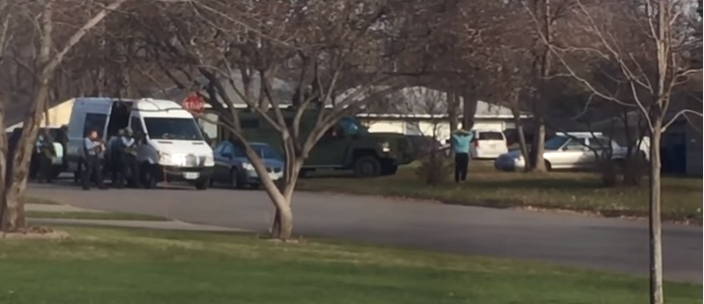
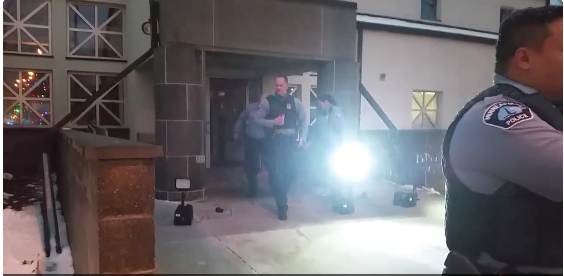
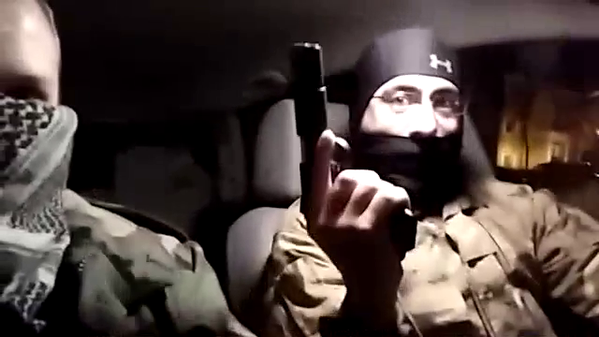
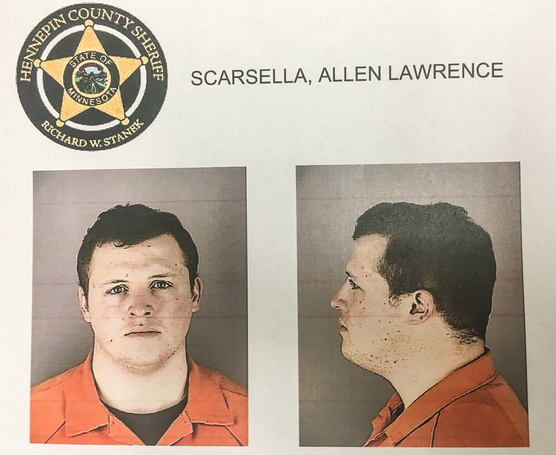
To help our volunteer-operated horizontally-organized non-profit media collective, please consider a tax-deductible donation:
Scarsella Trial Reportbacks & Coverage of Shooting at 4th Precinct:
- White Supremacists Shoot Five Protesters and MPD Attacks #Justice4Jamar Crowd - Nov 24, 2015
- “Play Stupid Games, Win Stupid Prizes”: White Supremacists Arrested for Shootings - Nov 26, 2015
- #Justice4Jamar Assailants Net Minor Charges; Camp Braces for Police Action - Nov 30, 2015
- Hiding Hate Crimes: Prosecutor Goes Easy on Attempted Murderers - Mar 15, 2016
- Bail Motion Denied for White Supremacist 4th Precinct Shooter - July 6, 2016
- Reportbacks From the Scarsella Trial (Ten Part Series) - May 1, 2017
- Scarsella Trial – Part One: Jury Selection, Unicorn Riot Subpoenaed, Opening Statements - Jan 27, 2017
- Scarsella Trial – Part Two: “In hindsight it was very stupid” - Feb 4, 2017
- Scarsella Trial – Part Three: Jury Sees Videos Around Mass Shooting - Mar 4, 2017
- Scarsella Trial – Part Four: Shooting Victims Testify - Mar 8, 2017
- Scarsella Trial – Part Five: Cell Phone Extraction Shows Scarsella’s Hardened Racism - Mar 13, 2017
- Scarsella Trial: Part Six – Defense Attempts to Discredit Protesters Using Police Videos - Apr 12, 2017
- Scarsella Trial – Part Seven: Co-Defendant Waives his 5th, Testifies for White Supremacist - Apr 25, 2017
- Scarsella Trial – Part Eight: Scarsella Takes Stand, Admits Shooting, Claims Self-Defense - Apr 26, 2017
- Scarsella Trial – Part Nine: Defense Rests & Closing Statements - Apr 26, 2017
- Scarsella Trial – Part Ten: Scarsella Guilty of 12 Felonies, Sentenced to 15 Years - Apr 27, 2017

